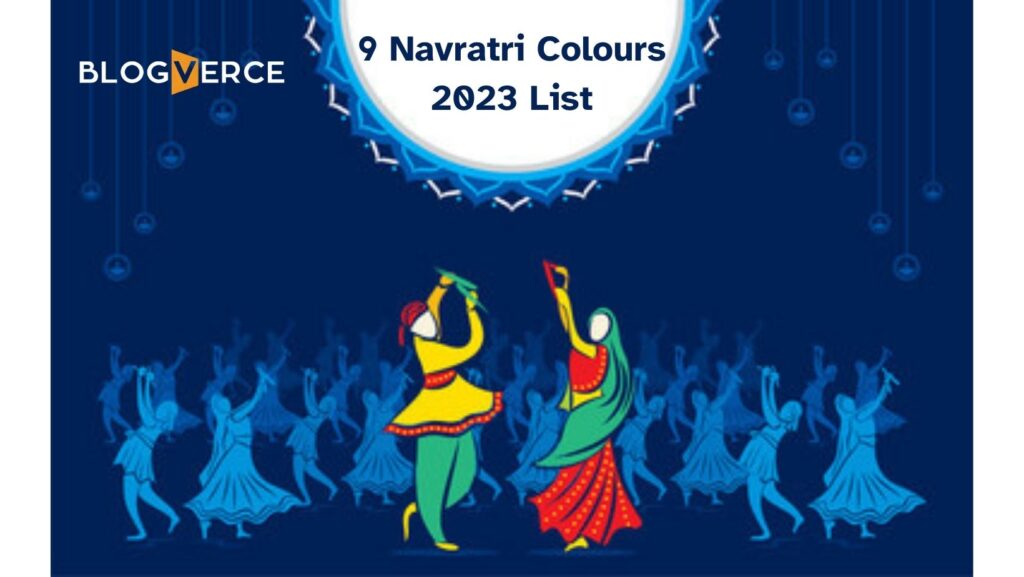
The nine days of Shardiya Navratri this year will begin on October 15 and end on October 23. Shardiya Navratri is a very important festival for people belonging to the Hindu religion. It falls in the month of Ashwin according to the Hindu calendar. The 9 days of Navratri end with the celebration of Dussehra. Devotees pray to the nine forms of Goddess Durga during this festival and seek her blessings. And do you know each day of Navratri has an assigned colour which has its own significance and value?
Each day of Navratri has a distinctive colour association and a significant spiritual significance. These colours are typically orange, white, red, royal blue, pink, and purple, as well as yellow, green, grey, and orange. Before learning the importance of Navratri’s colours, let’s first learn more about Navratri and its various forms.
The First Day: Orange
Orange is a color of great significance during Navratri, the nine-night Hindu festival dedicated to the worship of Goddess Durga. This vibrant and energetic color carries several symbolic meanings and plays a crucial role in the overall celebration of Navratri.

Orange Colour – A Divine Hue
the color orange in Navratri is far from just a visual element; it carries profound spiritual and cultural significance. It represents spiritual awakening, energy, and enthusiasm, serving as a beacon of positivity and optimism. By donning orange attire and incorporating this color into their celebrations, devotees embrace the vibrant and transformative aspects of the festival, connecting with the divine and seeking inner growth and enlightenment.
The Second Day: white
The color white holds significant importance during Navratri, the vibrant Hindu festival celebrated over nine nights. Each of these nine nights is dedicated to the worship of Goddess Durga, and during this time, devotees wear specific colors associated with each day. White, typically worn on the sixth day of Navratri, carries profound symbolism and significance.

White as a Symbol of Purity
- Symbol of Purity: White is often associated with purity and cleanliness. It symbolizes a state of being untarnished and unblemished. In the context of Navratri, it represents the pure and divine nature of Goddess Durga.
- Goddess Durga’s Essence: The color white is believed to embody the essence of Goddess Durga, who is considered the epitome of purity and spirituality. Devotees wear white to connect with her divine and untainted form.
- Cleansing the Soul: Navratri is not just about outer appearances; it’s also about inner purification. Wearing white during this time signifies the devotee’s desire to cleanse their soul, seeking spiritual growth and enlightenment.
- Peace and Serenity: White is a color that evokes a sense of peace and tranquility. It represents a calm and peaceful state of mind, which is essential for spiritual contemplation and meditation.
- The Light of Wisdom: White is often associated with the light of knowledge and wisdom. By wearing white during Navratri, devotees seek the wisdom and enlightenment that Goddess Durga can bestow upon them.
The Third Day: Red
The color red holds immense significance during the festival of Navratri, which is celebrated with great fervor by Hindus in India. Here’s why the color red is so important during this auspicious time

Red – The Color of Power
- Symbolizes the Power of Goddess Durga: Red is the color associated with the fierce and powerful form of Goddess Durga. It symbolizes her strength and her readiness to combat evil forces. During Navratri, devotees believe that by wearing red, they can invoke the protective and mighty energy of the goddess. This color signifies her determination to annihilate the demons and bring peace to the world.
- Represents the Chakra of Muladhara: In Hinduism, the color red is associated with the Muladhara or the root chakra. This chakra is believed to be the seat of our basic instincts and primal energy. Wearing red during Navratri is thought to activate and balance this chakra, providing stability and a sense of security. It’s also believed to enhance one’s physical and mental strength.
- Festive and Auspicious: Red is a vibrant and festive color that adds to the overall celebratory atmosphere of Navratri. It is often used in the decoration of homes and temples, including the use of red flowers, fabrics, and ornaments. The color red is believed to attract positive energy and joy, making it a popular choice for clothing and decor during this festival.
- Expresses Devotion and Fervor: Devotees wear red to express their unwavering devotion to Goddess Durga. It’s not just a color; it’s a symbol of their deep faith and reverence. Wearing red attire or accessories during Navratri is seen as an act of surrender to the goddess and a way of seeking her blessings.
The Fourth Day: Royal Blue
The importance of the royal blue color in Navratri is deeply rooted in the symbolism associated with this vibrant hue. Navratri is a nine-night Hindu festival dedicated to the worship of Goddess Durga, who is believed to be the embodiment of divine power and strength.

Symbolism of Royal Blue
- Symbolism of Power: Royal blue is often associated with power, authority, and strength. In the context of Navratri, it symbolizes the powerful and majestic aura of Goddess Durga. Devotees wear royal blue attire to connect with the divine energy and strength of the goddess.
- Depiction of the Goddess: The color royal blue represents the fearless and unyielding nature of Goddess Durga. It reflects her unwavering spirit in the face of adversity and her ability to conquer evil forces. The color serves as a visual reminder of her divine power.
- Seeking Divine Protection: During the first day of Navratri, wearing royal blue is believed to invoke the blessings and protection of Goddess Durga. Devotees seek her divine intervention to overcome obstacles, challenges, and negativity in their lives.
- Initiation of the Festival: The choice of royal blue as the color for the first day of Navratri is significant as it marks the beginning of the festival. It sets the tone for the nine-day celebration, infusing it with a sense of power and determination.
The Fifth Day: Yellow
The color yellow holds significant importance during the Hindu festival of Navratri. Navratri, which means “nine nights,” is a festival dedicated to the worship of Goddess Durga, who symbolizes the triumph of good over evil. Each of the nine days of Navratri is associated with a specific color, and yellow is one of them.

The Importance of Yellow
- Symbol of Happiness and Positivity: Yellow is often associated with brightness, happiness, and positivity. During Navratri, wearing yellow signifies the desire for a bright and joyful life. It represents the hope for a future filled with optimism and contentment.
- Spiritual Significance: Yellow is considered an auspicious and divine color in Hinduism. It is associated with knowledge and wisdom. Devotees wear yellow to seek blessings for spiritual growth and enlightenment during Navratri.
- Harvest Season: Navratri falls during the autumn season when the harvesting of crops begins. Yellow is the color of ripe grains and prosperity. It symbolizes a bountiful harvest and the abundance of food, making it an important color during this time.
- Sunshine and Light: Yellow is the color of the sun, the ultimate source of light and energy. It represents the divine radiance and the life-giving force. Devotees believe that wearing yellow during Navratri helps them connect with the energy of the sun and harness its positive vibes.
- Goddess Chandraghanta: Each day of Navratri is also associated with a different manifestation of Goddess Durga. The third day of Navratri is dedicated to Goddess Chandraghanta, who is depicted with a crescent moon on her forehead. The color yellow is believed to be her favorite, and wearing it is a sign of devotion to her.
- Cultural Significance: Navratri is not just a religious festival but also a celebration of culture and tradition. Wearing yellow attire, be it in the form of sarees, lehengas, or accessories, is a way to participate in the cultural and festive spirit of Navratri.
The Sixth Day: Green
The dark green color in Navratri holds great significance and symbolism. It is associated with the seventh day of the festival, and like all the other colors of Navratri, it carries a deep and meaningful message.

The Importance of Green
- Symbol of Fertility: Dark green represents the fertility of the Earth and the ability to bear fruit. During Navratri, this color is worn to seek the blessings of Goddess Durga for bountiful crops and prosperity in one’s life.
- Harmony and Balance: Dark green is a color of balance, signifying the equilibrium between growth and decay, life and death. It teaches us that all aspects of life are interconnected and that we must maintain harmony.
- Renewal and New Beginnings: The color dark green also signifies new beginnings and renewal. It encourages devotees to shed their old ways and embrace a fresh start, just as nature renews itself during the changing seasons.
- Nurturing and Protective Energy: Devotees believe that wearing dark green during Navratri invokes the protective and nurturing energy of Goddess Durga. It is a way to seek her guidance in providing for their families and safeguarding their loved ones.
- Connection with Nature: Dark green connects people with nature, reminding them of the importance of preserving the environment and living in harmony with the Earth.
The Seventh Day: Gray
Grey, often overlooked among the vibrant colors associated with Navratri, holds a significant place in this nine-night festival. While it may not be as eye-catching as the other hues, the importance of grey during Navratri is deeply rooted in its symbolism and spiritual connotations.
Grey is associated with the fourth day of Navratri, and it carries a profound message of transformation and balance. Here’s why grey is important in the Navratri celebration:

Grey and Its Meaning
- Symbol of Equilibrium: Grey represents the balance between light and dark. In Hindu philosophy, it is believed that life is a constant interplay between the positive and negative forces. Grey reminds us that harmony and equilibrium are essential in our journey to spiritual growth.
- Transformation of Negativity: Grey symbolizes the power to transform negativity into positivity. During Navratri, it serves as a reminder that with the divine grace of Goddess Durga, one can overcome obstacles, challenges, and adversities.
- Resilience and Strength: Grey may seem subdued, but it reflects inner strength and resilience. It signifies the ability to face difficulties with a calm and composed mind, just as grey remains steadfast amidst the chaos of colors during Navratri.
- Embracing the In-Between: Grey encourages us to embrace the in-between moments of life. It reminds us that not everything is black or white, and often, the answers and solutions lie in the nuances and subtleties of our experiences.
- Spiritual Growth: Navratri is a time for spiritual growth and self-reflection. Grey helps us in introspection and self-assessment, guiding us towards self-improvement and self-realization.
- Unveiling Inner Potential: Just as grey can be a canvas for many colors, it represents the potential within us. During Navratri, it encourages us to unveil our hidden talents and capabilities, much like the goddess’s ability to reveal her multifaceted nature
The Eighth Day: Purple
The color purple holds a unique significance in the context of Navratri, even though it’s not one of the nine primary colors traditionally associated with the festival. While the festival primarily focuses on nine specific colors, the color purple can still have a special place during Navratri for several reasons:

The Importance of Purple
- Spiritual Significance: Purple is often associated with spirituality, meditation, and higher consciousness. During Navratri, people engage in various forms of worship and spiritual practices, and the color purple can symbolize the spiritual journey and inner transformation that devotees seek during this period.
- Unity and Diversity: Navratri is a celebration of diverse cultural traditions across India. Purple, as a color that results from the combination of blue and red, can symbolize unity in diversity. It represents the amalgamation of various customs and rituals followed by people from different regions of India during the festival.
- Individual Expression: While the festival specifies colors for each day, there is room for personal expression and creativity. Devotees may choose to incorporate purple into their attire or decorations to express their individuality and personal connection to the festival.
- Devotion to Particular Deities: In some regions, devotees may associate purple with specific deities or forms of Goddess Durga. For instance, in some interpretations, the color purple is linked to the worship of Goddess Kalaratri, one of the forms of Durga known for her fierce and protective nature.
- Innovation and Contemporary Celebrations: With changing times, Navratri celebrations have evolved. Many modern interpretations of the festival incorporate a wider color palette, including purple, to make it more inclusive and appealing to younger generations. This adaptability reflects the dynamism of the festival.
The Ninth Day: Peacock Green
The importance of peacock green color in Navratri holds a special place in the nine-day festival dedicated to the worship of Goddess Durga. Each day of Navratri is associated with a different color, and peacock green is the designated color for the ninth day. This color carries profound symbolic meaning and significance in the following ways:

Peacock Green and Its Significance
- Divine Protection: Peacock green is believed to symbolize the divine protection and grace of Goddess Durga. It represents her watchful eye, which is always on her devotees, guarding them from harm and evil forces. Wearing peacock green on this day is a way to seek her protective blessings.
- Symbol of Renewal: Green, in general, is associated with growth, harmony, and new beginnings. As the concluding color of Navratri, peacock green signifies the renewal of life and the promise of a fresh start. It represents the rejuvenation of the soul and the opportunity to begin anew with the blessings of the goddess.
- Connection to Nature: The color peacock green is reminiscent of the vibrant and lush greenery found in nature. It is a reminder of the Earth’s fertility and the nurturing aspect of Goddess Durga, who is often associated with the bountiful aspects of life. This color reflects the connection between the goddess and the natural world.
- Harmony and Balance: Green is also a color of balance and harmony. It represents the equilibrium between light and dark forces, signifying Goddess Durga’s power to maintain equilibrium and eliminate obstacles from the lives of her devotees. It is a color that inspires a sense of inner peace and balance.
- Cultural Significance: In Indian culture, the peacock is often considered a sacred bird, and its vibrant green and blue plumage is associated with beauty and grace. By wearing peacock green during Navratri, devotees pay homage not only to Goddess Durga but also to the cultural symbolism associated with this majestic bird.
-
How to Incorporate These Colors
During Navratri, devotees incorporate these colors not only in their attire but also in their home decorations, rangoli designs, and even in the food they prepare. This adds to the festive spirit and the sense of devotion during this auspicious time.
-
Traditional Attire during Navratri
Traditional attire during Navratri includes lehengas, cholis, sarees, and dhotis in the specified colors. People love to dress up in vibrant, colorful clothing to pay homage to the goddess.
-
Conclusion
Navratri is not only a religious festival but also a celebration of culture, tradition, and colours. Each colour represents a facet of the divine goddess and holds deep spiritual significance. As you celebrate Navratri, embrace these colours to connect with the spiritual essence of the festival.
-
FAQs
- What is the significance of the nine colors of Navratri?
- Each color represents different attributes of Goddess Durga, and wearing them during Navratri is a way to connect with her divine energy.
- Can I wear any shade of the specified color during Navratri?
- It is ideal to wear the exact shade specified for each day, but variations are also acceptable.
- Are there any specific rituals associated with each color?
- While there are no specific rituals, many people perform pujas and prayers dedicated to the goddess in these colors.
- How do I decorate my home with these colors during Navratri?
- You can use these colors for home decor, such as flower arrangements, rangoli designs, and wall hangings.
- Is Navratri only celebrated in India?
- No, Navratri is celebrated by Hindus worldwide, making it a global festival that unites people in their devotion to Goddess Durga.
-
Important Notice
We have taken all this information from internal and external sources. We do not guarantee that all information is correct. There is a possibility that some information is wrong. We will not be responsible for any wrong information.


